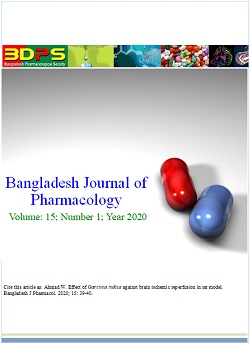Effect of Garcinia indica against brain ischemic reperfusion in rat model
Abstract
The term, ischemia, refers to a condition which is characterized by enormous reduction of glucose and oxygen. In cerebral ischemia, the cerebral blood flow become insufficient in order to pursue cerebral meta-bolic activities (Ahmed at al., 2018). Both, the inflammation and oxidative stress have a promising role in cerebral infarction associated with ischemic reperfusion insult. The reperfusion insult results in an initiation of a number of events including stress oxida-tive, devastation of blood brain barrier, leukocytes intrusion, inflammation, apoptosis and nitric oxide discharge, etc. In this context, potential antioxidant and anti-inflammatory intermediaries might play their role to lessen the effects produced as a result of ischemic reperfusion insult. Due to lack of active treatment of ischemic reperfusion associated cerebral ischemia, researchers interest in developing some effective therapy from medicinal plants is obvious (Kalogeris et al., 2012). In order to get to know about the mechanism of cell demise and neuroprotection, a classical rat’s model is widely used. In this model, the forebrain slices of the animal are bare to oxygen and glucose deficiency and reperfusion (Ca´rdenas et al., 2000). The advantages of this model are time tested as cell composition is preserved.
References
Ahmad W, Ahmad M, Khan RA, Mushtaq N, Kamdem JP, da Rocha JB. Neuroprotective effects of Melissa officinalis on oxygen and glucose deficiency induced damage in rat’s brain cortex slices. Int J Pharmacol. 2018; 14: 781-86.
Bahuguna A, Khan I, Bajpai V, Kang S. MTT assay to evaluate the cytotoxic potential of a drug. Bangladesh J Pharmacol. 2017; 12: 115-18.
Cárdenas A, Moro MA, Hurtado O, Leza JC, Lorenzo P, Castrillo A, Bodelón OG, Boscá L, Lizasoain I. Implication of glutamate in the expression of inducible nitric oxide synthase after oxygen and glucose deprivation in rat forebrain slices. J Neurochem. 2000; 74: 2041-48.
Kalogeris T, Baines CP, Krenz M, Korthuis RJ. Cell biology of ischemia/reperfusion injury. Int Rev Cell Mol Biol. 2012; 298: 229-317.
Kim J, Lee HJ, Lee KW. Naturally occurring phytochemicals for the prevention of Alzheimer’s disease. J Neurochem. 2010; 112: 1415-30.
Lenta B, Vonthron-Sénécheau C, Weniger B, Devkota K, Ngoupayo J, Kaiser M, Naz Q, Choudhary M, Tsamo E, Sewald N. Leishmanicidal and cholinesterase inhibiting activities of phenolic compounds from Allanblackia monticola and Symphonia globulifera. Molecules 2007; 12: 1548-57.
Liao CH, Ho CT, Lin JK. Effects of garcinol on free radical generation and NO production in embryonic rat cortical neurons and astrocytes. Biochem Biophys Res Comm. 2005; 329: 1306-14.
Mosmann T. Rapid colorimetric assay for cellular growth and survival: Application to proliferation and cytotoxyc assays. J Immunol Methods. 1983; 65: 55-63.
Wagner C, Vargas AP, Roos DH, Morel AF, Farina M, Nogueira CW, Aschner M, Rocha JB. Comparative study of quercetin and its two glycoside derivatives quercitrin and rutin against methylmercury (MeHg)-induced ROS production in rat brain slices. Arch Toxicol. 2010; 84: 89-97.
Woo KW, Kwon OW, Kim SY, Choi SZ, Son MW, Kim KH, Lee KR. Phenolic derivatives from the rhizomes of Dioscorea nipponica and their anti-neuroinflammatory and neuroprotective activities. J Ethnopharmacol. 2014; 155: 1164-70.

